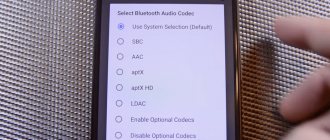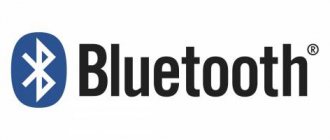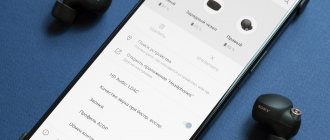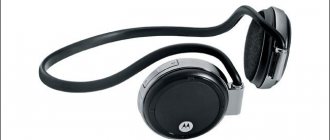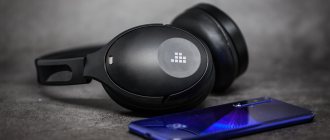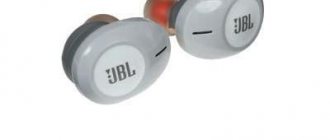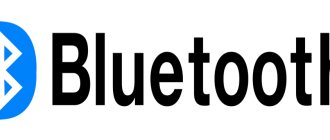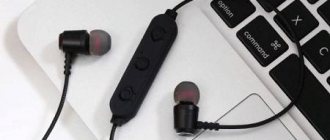4.8 / 5 ( 50 votes)
Home appliance stores offer a wide range of Bluetooth headphones, which are very popular due to their functionality and comfortable use. Wired analogues are preferred only by true audiophiles who enjoy the velvety mids. In order not to make a mistake in choosing the most suitable model, it is recommended to improve your knowledge in the field of codecs in headphones.
What are wireless headphone codecs?
Codec is a word made up of two other words “CODE” and “DECODE”. This concept name is an abbreviation-acronym. A Bluetooth codec is a program that, according to a given algorithm, first encodes information, reducing its size, and then decodes it for further playback.
What is Bluetooth Audio Codec
Codecs work on the following principle: an audio file of any format or a streaming service is played on the smartphone. Using a codec, a smartphone or tablet first encodes streaming information and then sends the already encoded signal to the headphones. The headphones, in turn, using the same codec, decrypt the received data, convert it into an analog signal and play music.
Note! For everything to work as expected, your smartphone/tablet/PC needs to support the same codec as your Bluetooth headphones. Otherwise, the information stream will not be decoded.
How do I know if my device supports the technology?
Today, not all smartphones support aptX. This is a technology developed by Qualcomm, and accordingly, it is supported exclusively on the equipment and software of this manufacturer. The CSR8675 sound processor with Bluetooth 5 has the necessary functionality. Xiaomi, Samsung, iPhone and a number of other smartphones can be equipped with it.
How to determine which smartphones support AptX and which do not:
- Download the free Wireshark program on your computer.
- We synchronize the smartphone with the headphones via Bluetooth and turn off the wireless function.
- Open the “Settings” application on your smartphone, go to the “About phone” section.
- We look for the line “Build number” and quickly click on this entry 7 times at a fast pace. The successful completion of the procedure is indicated by a message about enabling developer mode.
- Open the “Developer Options” section and enable “Bluetooth HCI Tracking Log”.
- We launch Bluetooth and headphones, and then turn on the music. We wait a couple of seconds and turn off the function enabled in the previous paragraph.
- We pair the PC with the phone and extract the file /sdcard/Android/data/btsnoop_hci.log from the phone’s memory.
- Open the file via WireShark. Here we see the following entries Audio non-A2DP APTX, Audio SBC
- this means that there is support for APT-X and SBC.
SetConfiguration - APT-X
command means that APT-X technology is used to transmit audio.
Types of codecs for Bluetooth headphones: advantages and disadvantages
Many connoisseurs of quality and comfort are wondering what codecs are used in modern headphones. In reality there are many of them. They differ in the data transfer rate per minute (bitrate), the calculation algorithm for encoding/decorating streaming information. The compression algorithm itself is also different.
What are the best codecs for headphones today?
- AptX HD
- A.A.C.
- AptX
- LDAC
- SBC
It is better to familiarize yourself with the operating features of each codec in more detail.
TOP 5 Bluetooth codecs - which codec is better?
All Bluetooth codecs are lossy compression algorithms.
- The signal is divided into several frequency bands (their number differs for different codecs) and quantized with a constant or different bit depth.
- During compression, some information is “cut off”, some is added.
- Errors and quantization noise are, if possible, transferred beyond the boundaries of human hearing : to frequencies that are often absent after “unpacking”.
AptX HD
Headphones with aptX HD
AptX HD is the best and most advanced codec for Bluetooth headphones in the aptX version. Numerous experiments conducted in laboratory conditions have proven that the HD version is capable of transmitting sound with minimal delays and higher sound quality.
Many marketers speculate on this codec, saying that if wireless headphones are equipped with it, the sound will be incredible. In reality this is not the case, despite the fact that he is one of the best today. The AptX HD codec is capable of almost completely covering the human audible range, with a maximum limit of 19 kHz. These values are quite acceptable, since people over 25 years of age rarely detect sound vibrations above 18 kHz.
The maximum bitrate is 576 Kbps. During the compression process, the audio track is divided into 4 frequency bands and quantized into 24 bits. As for the background noise level, it is far from 24-bit audio, especially in the high frequency range. Distortion and various noises are present.
- high bitrate (data transfer rate)
- in most cases the sound quality is better when compared to AAC, SBC and aptX
- wide dynamic range
- wide frequency range
- Not many wireless headphones support this codec
A dozen receivers and receiver-transmitters with AptX codecs
Today, the Bluetooth protocol is the most common tool for transmitting data and audio signals via radio waves over short distances. Phones, tablets, laptops, many TV boxes, modern audio systems, etc. and so on. incorporate Bluetooth modules, which allows some devices to be transmitters, others to receive a signal, and ultimately get rid of wires and cables connecting the source and receiver of data or sound.
What to do in a situation where you have bluetooth headphones, but the TV does not have a bluetooth transmitter, but you want to watch it at night and wirelessly, or you have a phone with a lot of music, but the radio in your car does not have a bluetooth receiver?
You can get out of the situation using some kind of adapter. Bluetooth receivers and transmitters serve as just such adapters, i.e. receivers and transmitters. Often one gadget performs two of these functions at once.
The principle of use will be better explained by an illustration using the example of one of the gadgets described below.
The selection includes a dozen receivers and receiver-transmitters with different content and functionality, but they all support AptX codecs.
The simplest gadget on offer is a Bluetooth receiver with an interesting design. The device is based on the QCC3005 chip, Bluetooth version 5.0. Connection to headphones or speakers (speakers), amplifier via Aux 3.5, battery capacity 110 mAh, codecs SBC, AAC, AptX, AptX LL. There is a built-in microphone, i.e. can work as Hands free.
The next Bluetooth receiver from an already well-known manufacturer is Baseus BA03. It is already built on the basis of the QQC3008 chip. Bluetooth version 5.0, 120 mAh battery, Aux connection, excellent set of codecs SBC, AAC, AptX, AptX LL, AptX HD. Another plus is the presence of a clip for attaching the receiver to clothing. There is a battery status indicator. Well, the appearance is beyond praise.
Compact bluetooth receiver-transmitter HAGIBIS MG-X3 with a clothes clip, Aux connection, fifth version of bluetooth. The chip here is the long-proven CSR8675 with a set of SBC, AAC, AptX, AptX LL, AptX HD codecs. The dimensions of the cylindrical case are only 57*12 mm. Can transmit sound to two pairs of headphones at once. Operating time in transmitter mode is 8 hours. in receiver mode 4 hours.
DISOUR Bluetooth adapter - works in receive and transmit modes, has a more familiar appearance, and is equipped with a premium CSR8675 chipset. Sound can be transmitted to two pairs of headphones for two people. The set of codecs is the same as the previous one - SBC, ACC, AptX, AptX LL, Aptx HD. There is a built-in microphone and connects via Aux.
I personally use a receiver-transmitter from a well-known manufacturer Ugreen CM108 or 40762E. This model has been on the market for a long time and is built on the CSR8670 chip, but the chip is still relevant and produces excellent sound quality without delays when watching videos. Bluetooth version 4.2. It is trained in SBC, ACC, AptX, AptX LL codecs and can work for more than 10 hours on a single charge. Can simultaneously transmit sound to two pairs of headphones. Nice design and excellent quality.
Further devices with the ability to receive and transmit not only via Aux, but also via SPDIF to obtain crystal sound quality!
I would especially highlight the Blitzwolf BW-BR3 receiver-transmitter. I personally used it, the quality is excellent! Made in the shape of a puck with buttons on the top side. There is also a CSR8670 here. Like the previous gadget, it can work while charging. The codecs understand SBC, ACC, AptX, AptX LL, but the main feature is the presence, in addition to Aux, SPDIF input and output. You can find a review of this model in my profile. Connects with two pairs of headphones. There is volume control and track switching.
The next bluetooth receiver-transmitter Nsendato is even more advanced. It is built on the CSR8675 chip and works using the Bluetooth protocol version 5.0. Equipped with Aux input/output and SPDIF input/output, there is volume control and track switching. In addition, the gadget will blink its LED and tell you which codec it is currently working with: AptX HD - four flashes in five seconds, AptX LL - three flashes, AptX - two, SBC - one. Battery 600 mAh, 20 hours of continuous operation.
The receiver-transmitter from VIKEFON is equipped with a smaller battery - 250 mAh, but is also built on a Qualcomm CSR8675 chip. It can connect to a sound source or actuator only via Aux, but it has its own advantage - it displays each mode and codec with separate LEDs, i.e. You can always know which codec is currently in use. In addition to the set of SBC, ACC, AptX, AptX LL, Aptx HD, there is a microphone, volume control and track switching. Interesting gadget.
The above gadgets have a standard range of 10 meters. For those who don't find this enough, there are devices with a range of 50 and 80 meters!!! These devices are equipped with external antennas and resemble routers.
The EKSA Bluetooth receiver-transmitter can transmit and receive a signal at a distance of up to 50 meters. There is already a full set of inputs and outputs. Here Bluetooth 5.0 and CSR 8675 with a set of codecs SBC, ACC, AptX, AptX LL, Aptx HD. They work both when transmitting and receiving signals. There is no microphone, but there is an LED codec indication and volume control with track switching.
And the last gadget in the selection is a record holder. It can receive and transmit signals over a distance of up to 80 meters! This is a gadget from the company Nsendato. There is also Bluetooth 5.0, CSR8675 chip and SBC, ACC, AptX, AptX LL, Aptx HD codecs. There is an indication of the selected codec and input/output, switching tracks and adjusting the volume. In addition, it is possible to work with two pairs of headphones and two signal sources, and there is also an NFC function. Battery capacity 1000 mAh.
Great sound everyone!!!
A.A.C.
AAC audio codec
AAC (Advanced Audio Coding) is a codec developed for Apple devices. It has a complex implementation and is based on psychoacoustics. If you use a pair of iPhone and AirPods, the sound will be at a very high level. This codec is also supported by some models of wireless headphones from Sony.
The AAC codec begins to cut off the frequency very early, around 14 kHz. Even older people can pick up such frequencies. The bitrate of this codec is the lowest and is only 252 Kbps. This indicates a noticeable compression of the sound.
If we talk about the quality of the connection, then the AAC codec has the highest quality. Considering the low bitrate, this seems quite logical and understandable.
- the algorithm is based on psychoacoustics, therefore, the development took into account the peculiarities of the operation and construction of the human hearing aid
- reliable connection
- When using Apple technology, high quality sound transmission is ensured
- practically not used outside the Apple ecosystem
- high dependence on a specific device; Android devices are practically not optimized
AptX
Headphones with aptX
AptX is a very common codec characterized by good sound quality. The only codec that is probably even more common is the SBC codec. Almost all devices running Android OS are equipped with support for this codec. This allows you not to worry about the operation of the headphones even if you buy a new smartphone.
The frequency range of AptX is practically no different from its previous predecessor. It is possible to “cut off” only frequencies above 19 kHz. The maximum bitrate reaches 352 Kbps.
In terms of background noise, the AptX codec is really close to 16-bit audio. Especially if you take into account the average volume level and the average human hearing. The quality of the connection under average conditions is quite stable; seconds start to be lost at -80 dBm.
What about other manufacturers?
Those users who want to enjoy truly high-quality audio should buy not only smartphones with AptX, but also headphones. Only codec support on both devices guarantees maximum sound quality. Fortunately, any flagship smartphone has this technology on board. Samsung is introducing it with the Galaxy S7, and Meizu, which returned in 2022 with the top-end phone Meizu 17, has always been famous for the sound in its devices. There is no need to talk about other major manufacturers - OnePlus, Huawei, Xiaomi, Realme, OPPO and others provide AptX support in expensive models. Unfortunately, not all modern flagships are available, so below are the best smartphones with AptX with a more reasonable price tag.
LDAC
LDAC Audio Codec
LDAC is a high-resolution Bluetooth codec that streams information in near-CD quality. The bitrate (data transfer rate) is higher when compared with other analogues. However, numerous experiments have shown that the sound quality is not far from aptX HD, the stability of operation is slightly worse.
The LDAC codec is able to “exist” in three different bitrates: 990 Kbps, 660 Kbps and 330 Kbps. As for the frequency range, it reaches 47 kHz, which approximately corresponds to the Hi Res mode. The background noise level in part of the range is quite consistent with 24 bits. However, there is a lot of noise at high frequencies.
The connection quality is at a high level LDAC. Gradual packet loss is observed at -80 dBm.
- high sound quality
- technical parameters are similar to 16-bit audio
- wide dynamic and frequency range
- maximum bitrate among Bluetooth codecs
- Poor sound quality in connection priority mode
- not very widespread yet
- unstable connection at frequencies 660Kbit/s and 990Kbit/s
SBC
SBC Audio Codec
SBC is the most widely used codec in the world and is supported by all wireless headphones and smartphones by default. There are many shortcomings in its work, but it all began with it and it is already known which codec will become its improved receiver - AC3. Reputable publications say that this will be a real breakthrough in wireless sound transmission.
The SBC codec is capable of transmitting frequency ranges up to 19 kHz inclusive. At the upper limit, distortion is much greater when compared with codecs from the artX line. The maximum bitrate is 320 Kbps, the expected compression is 4.4:1.
As for the level of background noise, there is much more noise here compared to other types of codecs. Officially, the SBC bitrate is not limited, but no device supports the SBC codec above 328 Kbps.
- supported by all Bluetooth devices without exception
- has a reliable connection
- Sounds better than AAC on some devices
- noises
- uneven bitrate distribution
Do Bluetooth headphone codecs affect sound quality?
Codecs really affect sound quality. However, these changes may be so minor that ordinary users simply will not notice it.
All of the previously listed codecs compress information with losses. Losses, as we know, can be useful and useless. Same with codecs. A person is able to detect sounds in the range from 20 Hz to 20 kHz. The susceptibility of the upper limit depends on the individual characteristics of the body and the age of the person. So, codecs remove all audio information above a certain frequency.
